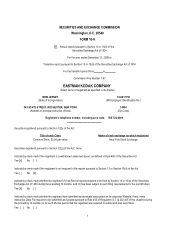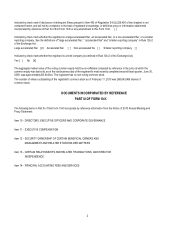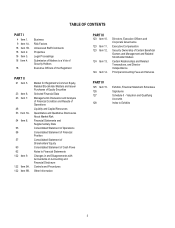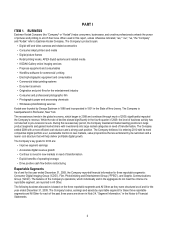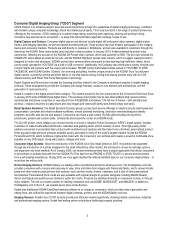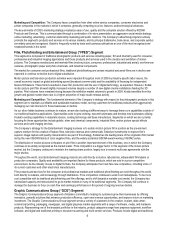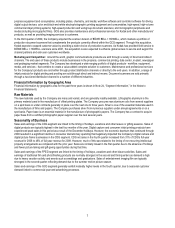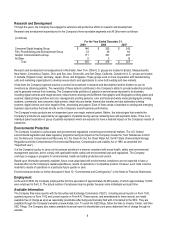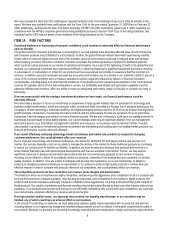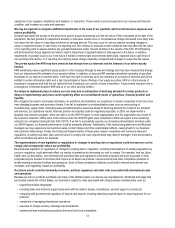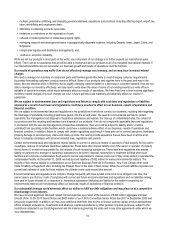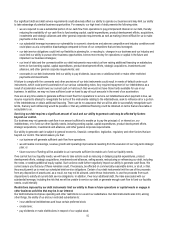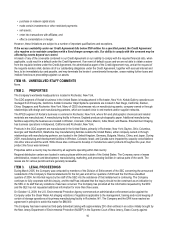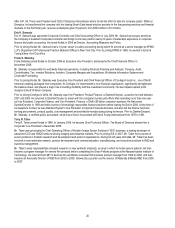Kodak 2009 Annual Report Download - page 13
Download and view the complete annual report
Please find page 13 of the 2009 Kodak annual report below. You can navigate through the pages in the report by either clicking on the pages listed below, or by using the keyword search tool below to find specific information within the annual report. 11
If we are unable to provide competitive financing arrangements to our customers or if we extend credit to customers whose
creditworthiness deteriorates, this could adversely impact our revenues, profitability and financial position.
The competitive environment in which we operate may require us to provide financing to our customers in order to win a contract.
Customer financing arrangements may include all or a portion of the purchase price for our products and services. We may also
assist customers in obtaining financing from banks and other sources and may provide financial guarantees on behalf of our
customers. Our success may be dependent, in part, upon our ability to provide customer financing on competitive terms and on our
customers’ creditworthiness. The tightening of credit in the global financial markets has adversely affected the ability of our
customers to obtain financing for significant purchases, which resulted in a decrease in, or cancellation of, orders for our products
and services, and we can provide no assurance that this trend will not continue. If we are unable to provide competitive financing
arrangements to our customers or if we extend credit to customers whose creditworthiness deteriorates, this could adversely impact
our revenues, profitability and financial position.
Our future pension and other postretirement plan costs and required level of contributions could be unfavorably impacted
by changes in actuarial assumptions, future market performance of plan assets and obligations imposed by legislation or
pension authorities which could adversely affect our financial position, results of operations, and cash flow.
We have significant defined benefit pension and other postretirement benefit obligations. The funded status of our U.S. and non U.S.
defined benefit pension plans and other postretirement benefit plans, and the related cost reflected in our financial statements, are
affected by various factors that are subject to an inherent degree of uncertainty, particularly in the current economic environment.
Key assumptions used to value these benefit obligations, funded status and expense recognition include the discount rate for future
payment obligations, the long term expected rate of return on plan assets, salary growth, healthcare cost trend rates, and other
economic and demographic factors. Significant differences in actual experience, or significant changes in future assumptions or
obligations imposed by legislation or pension authorities could lead to a potential future need to contribute cash or assets to our
plans in excess of currently estimated contributions and benefit payments and could have an adverse effect on our consolidated
results of operations, financial position or liquidity.
If we cannot attract, retain and motivate key employees, our business could be harmed.
In order for us to be successful, we must continue to attract, retain and motivate executives and other key employees, including
technical, managerial, marketing, sales, research and support positions. Hiring and retaining qualified executives, research
professionals, and qualified sales representatives is critical to our future. Competition for experienced employees in the industries in
which we compete is intense. The market for employees with digital skills is highly competitive and, therefore, our ability to attract
such talent will depend on a number of factors, including compensation and benefits, work location and persuading potential
employees that we are well positioned for success in the digital markets in which we are operating. Given that our compensation
plans are highly performance based and given the potential impact of the global economy on our current and future performance, it
may become more challenging to retain key employees. We also must keep employees focused on our strategic initiatives and goals
in order to be successful. Our past restructuring actions harm our efforts to attract and retain key employees. If we cannot attract
properly qualified individuals, retain key executives and employees or motivate our employees, our business could be harmed.
Our sales are typically concentrated in the last four months of the fiscal year, therefore, lower than expected demand or
increases in costs during that period may have a pronounced negative effect on our results of operations.
The demand for our consumer products is largely discretionary in nature, and sales and earnings of our consumer businesses are
linked to the timing of holidays, vacations, and other leisure or gifting seasons. Accordingly, we have typically experienced greater
net sales in the fourth fiscal quarter as compared to the other three quarters. Developments, such as lower-than-anticipated demand
for our products, an internal systems failure, increases in materials costs, or failure of one of our key logistics, components supply, or
manufacturing partners, could have a material adverse impact on our financial condition and operating results, particularly if such
developments occur late in the third quarter or during the fourth fiscal quarter. Further, with respect to the Graphic Communications
Group segment, equipment and consumable sales in the commercial marketplace peak in the fourth quarter based on increased
commercial print demand. Tight credit markets that limit capital investments or a weak economy that decreases print demand could
negatively impact equipment or consumable sales. In addition, our inability to achieve intellectual property licensing revenues in the
timeframe and amount we anticipate could adversely affect our revenues, earnings and cash flow. These external developments are
often unpredictable and may have an adverse impact on our business and results of operations.
If we fail to manage distribution of our products and services properly, our revenue, gross margins and earnings could be
adversely impacted.
We use a variety of different distribution methods to sell and deliver our products and services, including third party resellers and
distributors and direct and indirect sales to both enterprise accounts and customers. Successfully managing the interaction of direct
and indirect channels to various potential customer segments for our products and services is a complex process. Moreover, since
each distribution method has distinct risks and costs, our failure to implement the most advantageous balance in the delivery model
for our products and services could adversely affect our revenue, gross margins and earnings. Due to changes in our go to market
models, we are more reliant on fewer distributors than in past periods. This has concentrated our credit and operational risk and
could result in an adverse impact on our financial performance.


